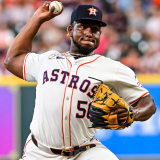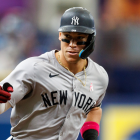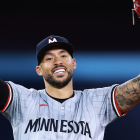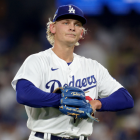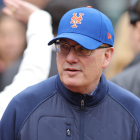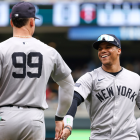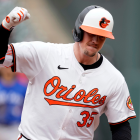In his very first game as a major-league manager, Gabe Kapler faced a big dilemma.
His Phillies scored five runs in the first six innings of their season opener against the Braves and looked to be in complete control. But when Ender Inciarte smacked a double to lead off the bottom of the sixth, Kapler's attention turned away from the 5-0 score. Instead, he saw the heart of the Braves order coming up with a runner on second and one out. This was starter Aaron Nola's third time through the order, and the sharp, analytically savvy skipper knew that starters typically perform far worse the third time through a batting order than they do earlier in games.
Given that this was also Opening Day and Nola might not be in midseason form, Kapler made the call. He pulled Nola from the game, despite the Phillies ace sitting on a three-hit shutout at the time, having thrown just 68 pitches.
Kapler's call failed miserably. The Braves rallied for eight unanswered runs, beating Philly 8-5 and leading the notoriously critical Philly fan base and media corps to wonder what the hell the new guy just did.
On May 27 against the Blue Jays, Kapler faced another big dilemma.
Nola had shaken off the pain of watching his team blow a big lead with him on the bench and gone on to establish himself as one of the best pitchers in all of baseball. He had stymied Toronto for six innings, holding the Jays hitless.
Then came the rain. Nola and his teammates watched the drops splatter onto Citizen Bank Park's field for 13 minutes. As Nola's arm gathered cobwebs on the bench, Kapler looked out at the Jays lineup, and surely noticed that his No. 1 starter would again be charged with carving through the opposition for a third time. This time, Kapler stuck with his ace. Two walks and a single later, Toronto had rallied to tie the game at 1, chasing Nola to the showers in the process ... after tying a career high by totaling 113 pitches.
Once again, Kapler's call had failed -- this time for riding his pitcher too hard, instead of not hard enough.
Only this time, the end result proved to be very different. Nick Williams slammed his league-leading third pinch-hit home run in the eighth, and the Phillies bullpen hung on to preserve a 2-1 victory. The win rocketed the Phils into first place for the first time in seven long years.
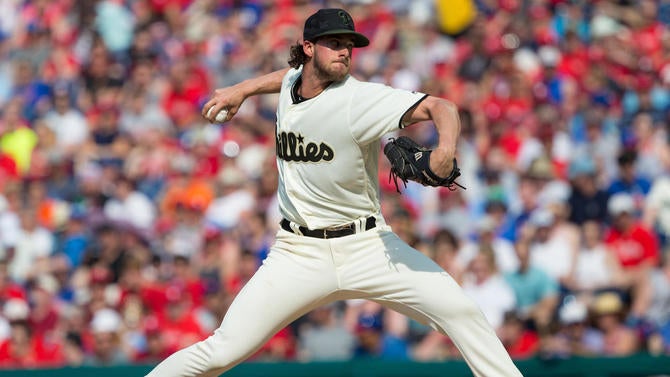
You could argue that Philly's rookie manager made two tactical errors, or that he made informed decisions that happened to not work out (at the very least he now knows he needs to have relievers warmed up before he can bring them in). But the bigger takeaway is that the Phillies' rebuilding effort has produced a collection of bright, young stars that is built to win, both now and for years to come.
As impressive as the Braves' turnaround has been this season, the Phils have made an even bigger leap. After winning just 66 games last year, Philly is on pace to win 94 this season, a colossal 28-game jump if the current rate continues.
Nola's two denied W's notwithstanding, the starting pitching has led the way. Phillies starters rank sixth in the majors in park-adjusted ERA and second in park-adjusted fielding-independent pitching, after ranking in MLB's bottom 10 in both categories last year.
The team's hard-luck ace has led the way. Long known for a devastating curve that complements his well-placed fastball, Nola's third pitch has keyed his huge 2018 breakout.
Aaron Nola Changeup
| YEAR | BATTING AVERAGE | USAGE RATE |
|---|---|---|
2016 | .333 | 8.5% |
2017 | .299 | 15.9% |
2018 | .215 | 22.7% |
With his changeup becoming a third effective weapon against opposing batters, Nola has entered the ranks of the league's elite, ranking in the top five in innings pitched, ERA and fielding-independent pitching.
Nola was the leader of last year's staff too, albeit with slightly less impressive numbers. The difference this year is that he has had lots of help.
When the price unexpectedly dropped for free-agent starter Jake Arrieta over the winter, the Phillies swooped in, nabbing him on a surprisingly affordable three-year deal. He has responded by posting a stellar 2.45 ERA, the second-lowest mark of his career behind only his magical 2015 campaign. Arrieta has lost a couple ticks off his fastball since that Cy Young season, and he's missing frighteningly few bats, posting a career low swing-and-miss rate and one of the weakest strikeout rates in the league. He's thriving instead by inducing tons of weak contact, flashing a career-high 56.3 percent ground-ball rate that ranks second among all National League starters.
Arrieta at least had a track record of success -- even if his plunging strikeout rate/low ERA profile might look a little perplexing. The bigger surprise has been the emergence of another right-hander this season. Nick Pivetta emerged as one of the most prolific strikeout artists in the game last year, fanning more than a batter an inning. Unfortunately both his command and his luck weren't nearly as cooperative. In just 133 innings of work, Pivetta issued an alarming 57 free passes. Even scarier, he served up 25 home runs, with more than 18 percent of the fly balls hit against him clearing the wall.
Pivetta's strikeout rate has found another gear this season, surging to 28 percent, sixth highest in the NL (rotation mate Vince Velasquez ranks fourth, and has shown promise in his own right). But the 25-year-old righty has slashed his ERA nearly in half to 3.23, thanks to walk and home runs that have also nearly halved. Check out the huge upticks in Pivetta's swinging strike rate, first-strike rate and chase rate, and you have a pitcher who's learning to harness his arsenal. If you're a Phillies fan, Pivetta's success becomes even more delicious when you consider that he was acquired for Jonathan Papelbon, the former closer who scrapped with Washington's best player and offered little else of value in D.C., while the Nats look up in the standings at a team that's being powered in large part by their former farmhand.
The Phillies were a hot sleeper pick this season, in large part due to optimism over their starting rotation. Still, trying to nudge above .500 is one thing. Hanging with the Braves and Nats in a fierce race for NL East supremacy is quite another. And it wouldn't be happening if not for Philly's incredibly patient approach at the plate.
The Phils rank third in the majors in walks, fueling a surge to 10th in on-base percentage; they ranked 22nd and 24th in those categories last year. Free-agent signee Carlos Santana was supposed to lead a more patient attack this year, and he has delivered his usual high bases on balls total, tying for sixth in the league with 32. Two teammates have bested him, though, with leadoff man Cesar Hernandez nearly doubling his walk rate to reach 33, and second-year slugger Rhys Hoskins' precocious batting eye tying him for third in the league, with 34.

Dig deeper and you can see Philly's commitment to grinding out at-bats the way some of the more successful Yankees and Red Sox teams have in recent years. Only one team's hitters have swung at the first pitch less frequently than the Phillies have this year; only five have taken more pitches.
Odubel Herrera has been the poster child for the Phillies' on-base success. Though he has walked about half as often as the club's leaders, he also built one of the most impressive streaks in the game's recent history. Herrera reached base in 45 straight games before having his streak snapped against the Cardinals on May 20. You could even argue that the streak should still be going, given what happened in his final at-bat that day.
ICYMI, this is how @odubelherrera1's on-base streak came to an end.#AtPhillies, being the rule-breakers we are, decided after much deliberation that we will not accept this. The streak is at 46* games.
— Philadelphia Phillies (@Phillies) May 21, 2018
We will not be taking questions. Thank you. pic.twitter.com/FtKHGBxdcJ
We're with the Phillies and call BS on that silly rule. Less silly: Herrera emerging as one of the best all-around players in baseball, batting a robust .331/.396/.519. The difference this season? Vastly improved results against lefties, with a .308/.379/.519 line against them this year, compared to just .271/.327/.379 in the first three years of his career.
Things could get really interesting in the weeks to come. General manager Matt Klentak moved to speed up the rebuilding process over the winter, signing Santana as well as relievers Tommy Hunter and Pat Neshek to multiyear deals. Even with Hoskins and multiple other dynamic young players crashing the big leagues, the Phillies' minor-league system is still loaded with talent.
Will the Phils dip into that stash of talent and make a blockbuster deal to strengthen their shot at their first division title since they won their fifth in a row in 2011? Or will they stay the course, letting a lineup that has just one hitter over 28 and just one pitcher over 26 continue to blossom, with a patient approach aimed at sustained, long-term success winning out over win-now impulses?
Given that this is the same team that went an abysmal 29-58 before the break last year, the fact that we're even asking that question is reason enough to celebrate.








